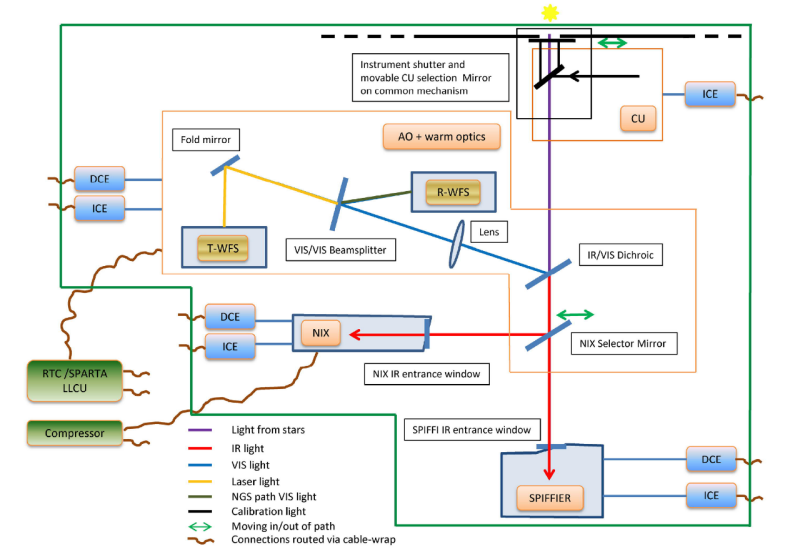ERIS Overview
ERIS is a Cassegrain instrument that will take over the fundamental adaptive optics capabilities at the VLT previously provided by NaCo and SINFONI (and operationally has many similarities to those instruments). ERIS instrument has two science cameras; SPIFFIER, an integral field spectrograph covering J to K bands, and NIX, an imager covering J to M bands.
Project details
Principal Investigator |
|
|---|---|
| Consortium |
|
| ESO Responsibles |
|
| Relevant References |
ERIS in a nutshell
IFS
- Twelve grating configurations: three low-resolution configurations spanning the complete J, H, or K bands (R~5,000), and nine high-resolution configurations (R~10,000), three for each band. The high-resolution gratings span approximately half of the band; one covering the first half, one covering the second half, and one centered at the middle of the band.
- Three plate scales corresponding to a field of view on sky of 0.8"x0.8", 3.2"x3.2", and 8"x8". Note that the spaxels (spatial pixels) are rectangular in the reconstructed image, with sizes of 12.5x25, 50x100, and 125x250 mas/spaxel, respectively.
- Can be operated without AO, with NGS AO (on or off-axis), with LGS AO, or with LGS-SE (seeing enhancer) AO if no suitable tip-tilt star is available.
- Non-sidereal and differential tracking are both supported.
- Field and pupil tracking are both supported.
NIX
- Short-wavelength (1.0-2.5 um) imaging: 26"x26" (13 mas/px) or 55"x55" (27 mas/px) field of view, narrow and broad-band filters
- Long-wavelength (2.5-5.0 um) imaging: 26"x26" (13 mas/px) field of view, narrow and broad-band filters
- Apodizing phase plate (APP) coronagraphy: can be used with narrow-band K and L filters, 13 mas/px camera.
- Focal plane coronagraph (FPC): L and M-band Annular Groove Phase Mask (AGPM) vortex coronaraph, 13 mas/px camera.
- Sparse aperture masks (SAM): three aperture masks (7, 9, 23 holes), 13 mas/px camera
- Long slit spectroscopy (LSS): L-band, R~900, 86 mas slit width, 13 mas/px camera.
- Non-sidereal and differential tracking are both supported.
- The following focal plane rotation modes and AO modes are available for each NIX observing mode:
| Field tracking |
Pupil tracking |
NGS on-axis |
NGS off-axis |
LGS | LGS-SE | noAO | |
|---|---|---|---|---|---|---|---|
| Short imaging | ✓ | ✓ | ✓ | ✓ | ✓ | ✓ | ✓ |
| Long imaging | ✓ | ✓ | ✓ | ✓ | ✓ | ✓ | ✓ |
| APP | ✓ | ✓ | ✓ | ||||
| FPC | ✓ | ✓ | |||||
| SAM | ✓ | ✓ | |||||
| LSS | ✓ | ✓ | ✓ | ✓ |
Adaptive Optics (AO)
- NGS: requires guide star with R<11 mag, either on and off-axis (up to 60" possible, although <30" recommended due to anisoplanatism).
- LGS: requires tip-tilt star within 60" with R=7-18 mag. Laser spot is initially on-axis, moving relative to target as telescope offsets are applied.
- Seeing enhancer (SE): uses LGS to correct for high-order aberrations only. No tip-tilt star required, only VLT field stabilisation.
- No AO: seeing limited, only uses VLT field stabilisation.
Calibration Unit (CU)
- Quartz-Tungsten halogen lamp for flat fielding/linearity.
- Four pencil-ray lamps (Ne, Xe, Kr, Ar) for wavelength calibration.
- Laser driven light source (LDLS) to generate artifical optical/infrared point and extended source, and a backlit three-slit.
- The CU cannot be used when the telescope is not at zenith due to instrument flexure.
Schematic Diagram

